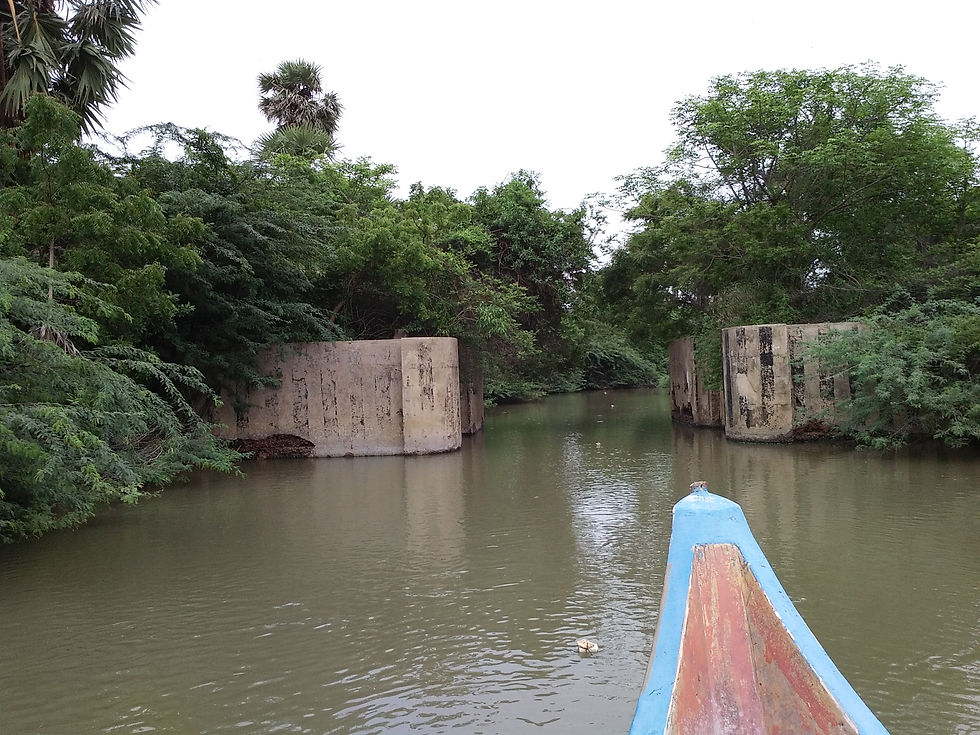
Art & Architecture Research Development & Education [AARDE] Foundation

PULICAT
Bird Watching Spot
Nelapattu
Bird
Sanctuary
Pulicat (பழவேற்காடு) is famous for its wetland which covers an area of 759 sq.km. Located on the north of Chennai city at 55th km. The Lagoon is considered to be the second largest water body in India. the water body is shared by two states, Andhra Pradesh and Tamilnadu. The world famous rocket launching and research organisation ISRO is located in the centre of the lagoon (கடற்கழி).
Two thousand years of maritime history could be traced in the villages of Pulicat Lagoon. Asia's largest European cemeteries are located in Pazhaverakadu, Tamilnadu. More than eighty thousand migratory birds visit this waterbody. The famous palaykat lungi or sarong had its origin from this region due to the finest quality of cotton and weaving.
Pulicat Lagoon has two parts - lake & marshy/dry land. The road connecting Sullurpeta and Sriharikota-island divide the wetland. Popularly known as Pulicat-Lake is in the south of the road. The northern part will be marshy or dry depending upon seasons. The three rivers that bring fresh water during winter monsoon are Arani, Kalagi, and Swarnamukhi. Three sea-water inlets make the water brackish.
Unlike the western ghats, the southeast coast of India depends on wetlands to attract rain clouds. The wetlands play a major role in attracting northeast monsoon during the winter season. However, its gloriest natural and built values are in vanishing. We AARDE working towards the promotion and conservation of this fragile environment.

More than 80000 birds visit Pulicat Sanctuary during winter monsoon period.

Drawn by Johannes Vingboons

Detailed map drawn to scale of Pazhaverkadu village

Anonimo, Portuguese a traveler sketch

Painting of Pazhaverkadu village in 1650 CE. A drawing by Dutch traveler.

Asia's largest European cemetery. Located in Pazhaverkadu village, Tiruvallur District, Tamilnadu

A small information center maintained by AARDE Foundation at Pazhaverkadu village

Vijayanagara Temple built during 1330s. Was damaged during 2013 due to unprofessional conservation work

only surviving Church in Kottai-kuppam village. However, India's first Christian church 'Our Lady of Snow' built in 1515 was demolished in 2008

17th century mosque built in Dravidian architecture. This mosque was built sea-route Muslims. Islam came to Tamilnadu [& Pulicat] during 8th century

1640s - Oldest Maritime Heritage in Coromandel Coast. Was used as a Governor Office to collect tax from European ships visiting Pulicat.

1657AD Tombstones with intricate carvings - unimaginable style and detailing.

India's first European fort was built in Pazhaverkadu [Pulicat] in 1602 by the Dutch. This fort was built on above the Portuguese fort.

In 1602, the Dutch East India Company issued and traded shares to increase its voyages to Asia, particularly to Pulicat. This picture is the oldest share-document in the world. Displayed in Archives in Hroon, The Netherlands.

Traditional palmyra tree leaf craft was brought to Pulicat by the Arab trades. More than thousand years old craft is still practices in Pulicat.

16th century textile made in Pulicat region is displayed in Brooklyn museum, USA. The Cotton cloths were exported to Middle-east, Japan, S.E.Asia, and Europe for more than milleniums.

Palaykat or Pulicat Sarong/Lungi is well known product around the Asian, Japan, Mexico, & Middle East countries. For several centuries, trades from around the globe traded for Pulicat textile in exchange of gold and silver.

Padu system is a lagoon's resource management system. The practiced is followed by the fishermen for several centuries. This sustainable traditional practice was protecting the wetlands for centuries.

ODAVI Traditional boat making community. Sangam literature says they were the most trained craftsmen in building ships and boats to take goods across the global.

Britisher erected miles stones from Basin Bridge (Chennai) to Pulicat. This East Coast Canal mile's stones are unique to India.

802 km long canal from Vijayawada (Andhra Pradesh) to Marakanam (Tamilnadu) along the Bay of Bengal sea. This canal along with wetlands of S.E.Coast of India were shock absorber during tsunami and cyclone.

Yanadi Tribe - they have a traditional and sustainable fishing practice.

It is the only wetlands in India to have two light houses - Located at the ends of the water body. In the picture, you will find the old light house which was demolished in 1985.

Mud houses of Pulicat! It is resilient, cost-effective and easy to construct. Such houses could be seen along the northern border of the lagoon.

Pulicat beach stretching 70 km is famous for turtle breeding during winter monsoon. However, many get killed due to the modern fishing technique and technology.
Pazhaverkadu Village - Tourist Spots

PULICAT DAY Celebrations
Since 2011, World Wetlands Day is organised as the Pulicat-Day. To bring attention to this fragile lagoon, the days celebrated with traditional catamaran race, ecology-quiz, kolam competition, folklore activities, etc..






 |  |  |
|---|---|---|
 |  |  |
 |  |  |
 |  |  |
 |  |  |
 |  |  |
MADRAS DAY @ Pulicat
Birth anniversary of Madras city is glorified in Pulicat as trip every August month. TRACE ORIGIN OF MADRAS is a full-day tour to check starting point of modern history of India.
 |  |  |
|---|---|---|
 |  |  |
 |  |  |
 |  |  |
 |
ISRO
Rocket Launch center
Port
Port
Port
Holistic Strategy Map:


















